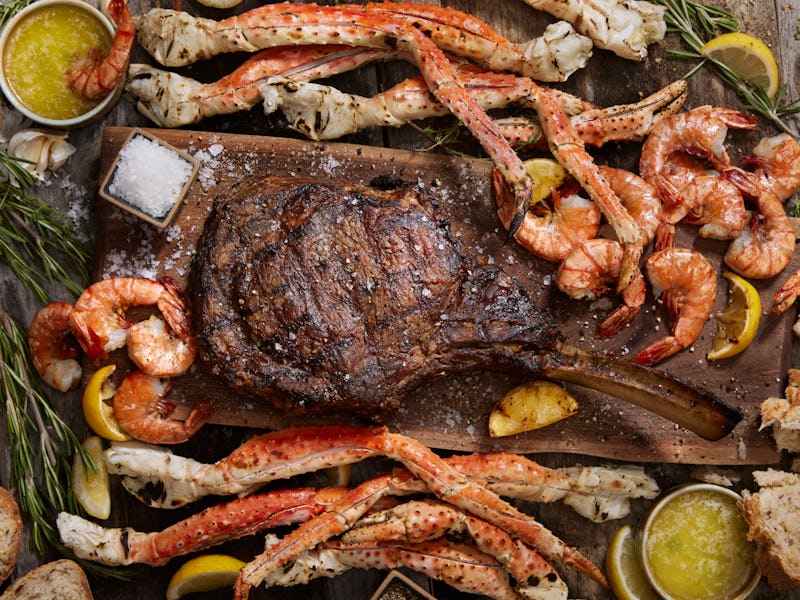Fish and seafood are better for your health and the climate than meat, study shows
Surf outperforms turf in wellness and sustainability.

The clarion call to shift to plant-based diets has resounded throughout the food industry. Plant-based nuggets, sausages, and patties are now more common on menus to cater to wider dietary needs and perhaps to help encourage curbing carnivorous appetites in the name of cutting emissions.
Another option that hasn’t yet reverberated in the same way is to switch over to fish and seafood. A Swedish paper published in 2019 laid out how a seafood diet may lie at the nexus of human and environmental health.
A new paper in Communications Earth and Environment takes this prior study a step further. It demonstrates that fish and seafood are the most efficient vessels for the key nutrients humans need.
What’s new — The study shows that seafood and fish are healthier than land-raised meats and that fishing production emits less greenhouse gas than farm animals. The paper also breaks down how many kilograms of greenhouse gas is emitted for every gram of protein, every omega-3 fatty acid, and every vitamin and mineral in a serving of seafood.
“Pushing beyond protein into this much more nuanced space is a frontier that was necessary for us,” Peter Tyedmers, co-author and environmental studies professor at Dalhousie University, tells Inverse.
The seafood in question:
- Salmonids (e.g., salmon, trout)
- Crustaceans (shrimp, lobster, crab)
- Cephalopods (squid)
- Whitefish (catfish, hake, cod, tilapia)
- Bivalves (mussels, scallops, oysters)
- Large pelagics (Tuna, albacore)
- Small pelagics (Anchovy, mackerel, herring)
This is a mere sampling of what the world’s oceans, lakes, and rivers hold, but they comprise a sizeable chunk of the fish and seafood market. Wild-caught salmonids had the highest nutritional value for the least greenhouse gas emissions, and crustaceans were the least nutritious but resulted in the most emissions.
Additionally, they analyzed 21 beneficial nutrients in all these creatures, plus two detrimental ones (sodium and saturated fat) to calculate as best as possible what each kilogram of CO2 released into the atmosphere feeds us. They conclude that the environmental (and economic) cost of seafood is much lower than that of meat.
Why it matters — Seeing the consequences of climate change in real-time spurs the need to do everything possible to create a more sustainable world — at least to curb further damage if we can’t reverse what’s been done. Raising land animals for food takes a hefty toll on the planet; the United Nations’ Food and Agricultural Organization found in 2013 that meat and dairy create 14.5 percent of global greenhouse gas emissions, coming in behind energy, transit, and manufacturing.
The study focuses on carbon emissions from production, rather than from transportation. Indeed, raising cattle and other red meat animals is a resource suck and a carbon-emissions belch.
Tyedmers also believes that vegetarianism and veganism across the board aren’t the answer to curbing climate change. He underscores that there’s another way to pack in nutrients in a climate-friendly way while cutting back or giving up on red meat. Co-author Elinor Hallström, a food researcher at RISE Research Institute of Sweden, says their findings indicate that compared to meat, seafood has more to offer in terms of easing greenhouse gas emissions than nutrients.
Digging into the details — This question could become infinitely more granular. Is wild-caught fish better than farmed fish? Is local always better than imported?
“If we reduce this to a fishing versus farming or carp versus salmon, we’ve missed the problem,” Tyedmers says. He points out that pursuit of the most perfect solution will inevitably lead to industry infighting, a conclusion he says is backed by his 20 years in the sustainable seafood sphere.
He acknowledges that this data is imperfect. It doesn’t answer every single question, nor does it proscribe a solution for every community in the world. As detailed as their formula is, there are, of course, populations that don’t eat fish or seafood or don’t live in a place where fish flourish.
What’s next — While the answer is always more research, Tyedmars’ most immediate hope is that consumers at least scale back their red meat consumption, opting for salmon instead.
He also wants to continue to investigate the modes of production to maximize efficiency. Nutritional analysis, he says, is just the beginning.
“We need to de-escalate our ruminant consumption massively, and here are some great alternatives.”
This article was originally published on